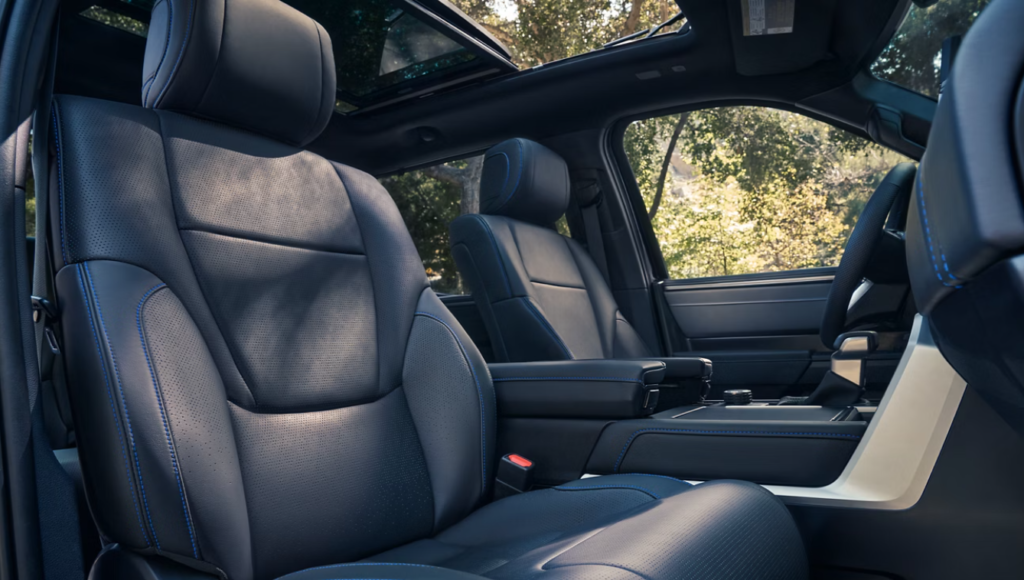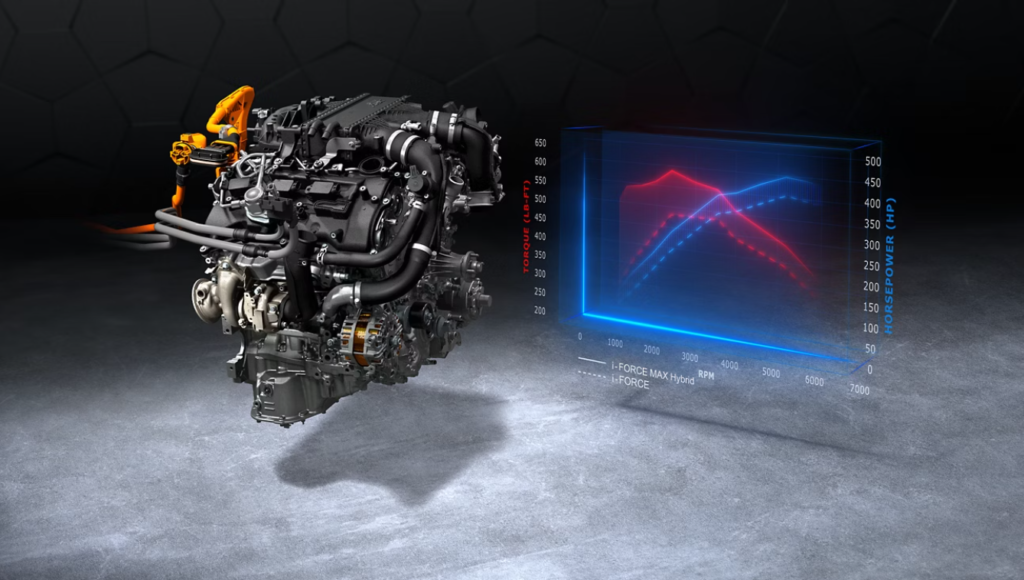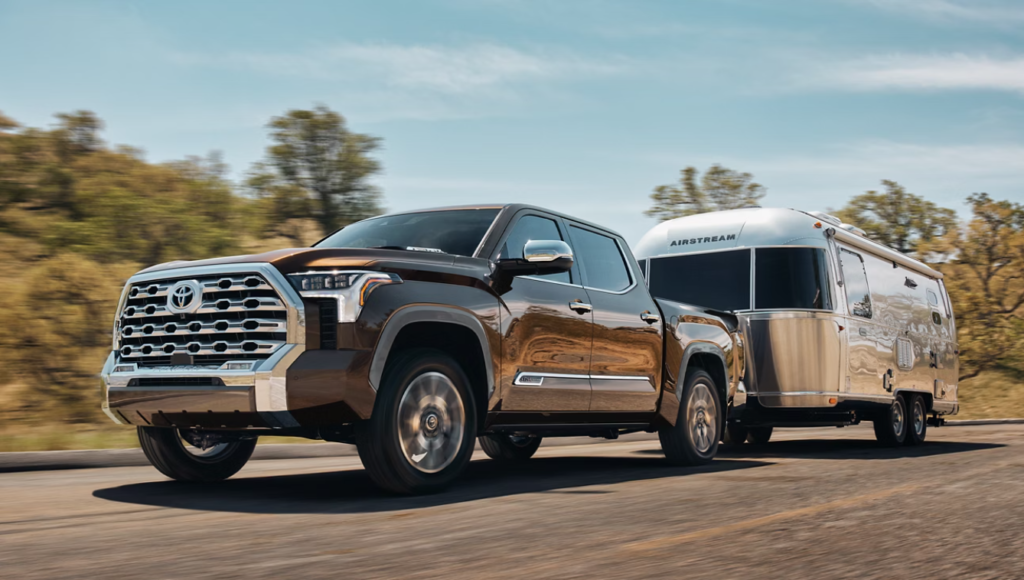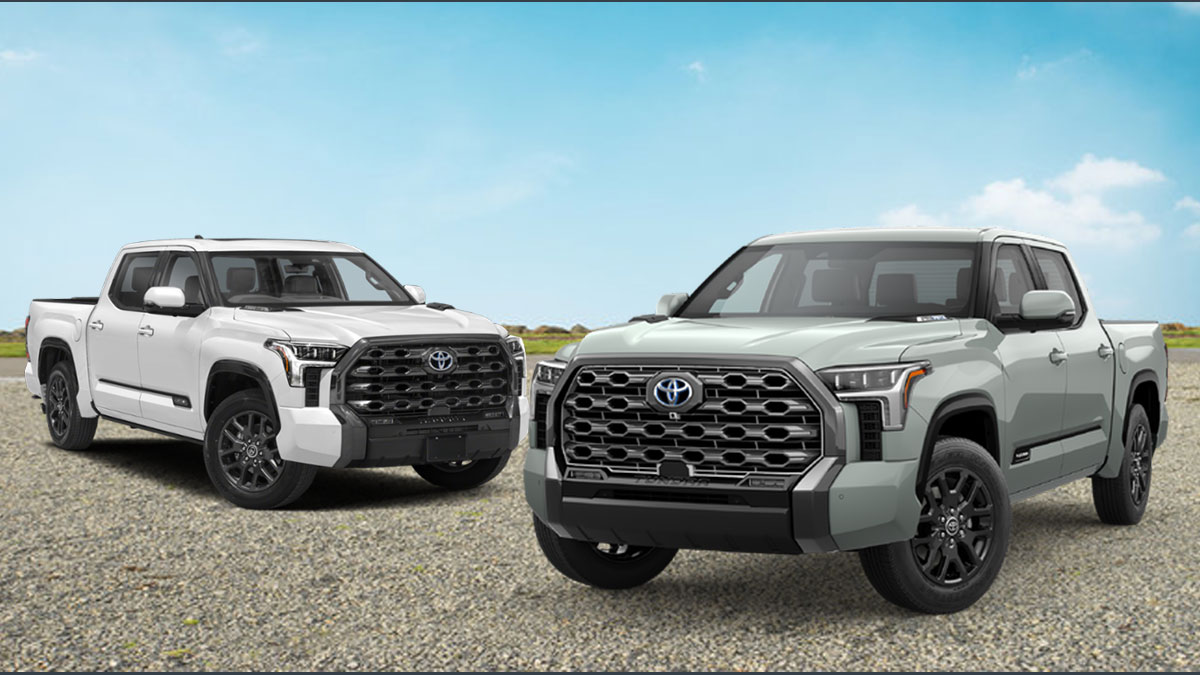When it comes to full-size pickup trucks, the Toyota Tundra has become a reliable and rugged player on the market. A few years ago Toyota extended the Tundra line with introduction of its new Tundra i-Force Max variant, which it claimed offers improved performance and gadgets. We will we will delve into the Tundra vs Tundra iForce Max comparison, matter in depth explore it from every angle, searching for the best way to help prospective buyers decide.
The Toyota Tundra Series
The Toyota Tundra is a full-size pickup truck that offers outstanding durability, reliability and capability. After it hit the market in 1999, Toyota put a still-ongoing series of updates and redesigns into developing the Tundra to compete better with its most established full-size pickup truck rivals as well as more recent changes with basic technology. The Tundra series is well known for its rugged construction, roomy interiors and off-road capabilities which make it a popular choice among those into truck business.
The Tundra Through History
The Tundra was Toyota’s entry into the full-size truck market that had long been the domain of Americas Big Three automakers when it burst onto the scene in 1999. Through the years we have seen a lot of evolution in the Tundra; long gone are days of V6 engine and no safety technologies, as single-cab pickup or small cargo truck. With each generation of the Tundra, numerous innovations and refinements have served to bolster its place as a respected force in this same class.
Introduction to the Tundra iForce Max
The Tundra iForce Max is something big for the Tundra lineup. Tagged as a higher-performance iteration, the iForce Max is billed to pack best-of-ever-before levels of power and efficiency in addition to tech. Designed to optimize the driving experience and respond to contemporary needs of truck users, it adds a new layer to Tundra lineage with the iForce Max.
Exterior Design and Styling Differences

The exterior design and styling differences between the 2024 Toyota Tundra i-FORCE MAX and the standard i-FORCE engine are subtle, as both models share a similar overall aesthetic. However, there are some distinctions worth noting:
Overall Design
- Shared Design Language: Both the i-FORCE MAX and standard Tundra feature the same bold and aggressive design, characterized by edgy, molded fenders, squared-off wheel wells, and a prominent front grille with chrome accents. The T-shaped LED lighting elements and rectangular headlights contribute to a modern look.
- Trim-Specific Features: While the base design is consistent, the specific trim levels available for each engine may introduce unique styling elements. The i-FORCE MAX is typically offered in higher trims (Limited, Platinum, 1794 Edition, TRD Pro, and Capstone), which may include additional chrome accents, upgraded wheel designs, and distinctive badging.
Weight and Dimensions
- Weight Difference: The i-FORCE MAX is approximately 600 pounds heavier than the standard i-FORCE due to the hybrid components, which can slightly affect handling characteristics but not the exterior styling.
- Cab and Bed Configurations: Both models offer various cab and bed configurations, but the i-FORCE MAX is limited to higher trim levels, which may restrict some options available for the standard engine.
Functional Features
- Hybrid Badging: The i-FORCE MAX models will feature hybrid-specific badging that distinguishes them from the standard models, indicating their hybrid powertrain.
- Wheel and Tire Options: Depending on the trim, the i-FORCE MAX may come with larger or more aggressive tire options suited for off-road performance, particularly in the TRD Pro variant.
The exterior design of the 2024 Toyota Tundra i-FORCE MAX and the standard i-FORCE engine is largely similar, the differences lie mainly in trim-specific features, weight, and hybrid badging. The overall aesthetic remains consistent, emphasizing Toyota’s commitment to a bold and functional design across both powertrains.
Interior Features and Comfort

When it comes to interior features, the Toyota Tundra interior features are designed with comfort and convenience in mind. The interior features of the 2024 Toyota Tundra i-FORCE MAX hybrid and the standard i-FORCE engine are largely similar, but there are some distinctions based on trim levels and available options. Here’s a comparison of the key interior features:
Interior Features Comparison
Common Features
Both the i-FORCE MAX and standard i-FORCE models share many interior features, including:
- Seating: Both models offer spacious seating with options for cloth or leather upholstery, depending on the trim level.
- Infotainment System: Both come equipped with a touchscreen interface that includes Apple CarPlay, Android Auto, and a premium audio system on higher trims.
- Climate Control: Dual-zone automatic climate control is standard on higher trims for both models.
- Storage Solutions: Ample storage compartments, including under-seat storage and a center console with significant space.
Differences
- Trim Levels: The i-FORCE MAX is generally available only on higher trim levels (like Limited and Platinum), which may include additional luxury features not found in the base models of the standard i-FORCE.
- Hybrid Components: The i-FORCE MAX includes a hybrid battery system that may slightly reduce interior storage space under the rear seat compared to the standard model.
- Unique Styling Elements: Depending on the trim, the i-FORCE MAX may offer unique interior color schemes and materials that enhance the overall aesthetic compared to the standard model.
While the core interior features of the 2024 Toyota Tundra i-FORCE MAX and standard i-FORCE are similar, the hybrid model typically includes more premium features due to its availability on higher trims. The choice between the two may come down to preferences for luxury options and hybrid technology versus a more traditional setup.
Tundra vs Tundra iForce Max Comparison
The Tundra vs Tundra iForce Max comparison is not just about stereotypical design and interior features. This includes performance, towing ability, fuel economy and overall driving feel. Looking at these differences should help the buyer make a decision as to which model is right for him.
Engine Specifications

The key differences in Tundra engine specifications between the 2024 Toyota Tundra i-FORCE MAX hybrid and the standard i-FORCE engine are:
Horsepower and Torque
- i-FORCE MAX Hybrid: 437 horsepower @ 5,200 RPM and 583 lb-ft of torque @ 2,400 RPM
- Standard i-FORCE: 389 horsepower @ 5,200 RPM and 479 lb-ft of torque
The i-FORCE MAX hybrid produces an additional 48 horsepower and 104 lb-ft of torque compared to the standard i-FORCE engine, thanks to its electric motor assistance.
Engine Configuration
Both engines are 3.4L twin-turbo V6 designs, but the i-FORCE MAX adds a 288V electric motor between the engine and transmission for enhanced performance.
The standard i-FORCE engine has slightly better highway fuel economy, while the i-FORCE MAX hybrid is rated 1 MPG higher in city driving. However, the hybrid’s added weight offsets some of the efficiency gains.
Performance Differences
The Toyota Tundra offers two models of engine: the standard i-FORCE Engine and the i-FORCE MAX hybrid. Here are the key differences in performance:
Engine Power and Torque
Standard i-FORCE Engine: The engine can generate 389 horsepower and 479 lb-ft of torque, up from the 381 HP/401 lb-ft produced by an i-FORCE V8 in 2019. This means that with its 10-speed automatic transmission and available navigation two packages can be towed up to a maximum of 12,000 pounds; moreover, this vehicle has the ability (with base tires/hitch package installed) to carry 1,940 lbs in its bed.
i-FORCE MAX Hybrid Engine: It produces 437 hp and 583 lb-ft. This is critical, because the hybrid system strengthens performance–especially in towing and acceleration. But it also adds to vehicle weight, and complexity as well.
Overall, while the i-FORCE MAX provides superior torque and horsepower, the standard i-FORCE engine remains a robust option for those who prioritize reliability and simplicity without the hybrid’s added complexity who enjoy performance while being prudential in terms of their consumption.
Acceleration and Power
The acceleration and power comparison between the 2024 Toyota Tundra i-FORCE MAX hybrid and the standard i-FORCE engine is as follows:
Power Output
- i-FORCE MAX Hybrid:
- Horsepower: 437 hp
- Torque: 583 lb-ft
- Standard i-FORCE Engine:
- Horsepower: 389 hp
- Torque: 479 lb-ft
The i-FORCE MAX offers a significant increase in both horsepower and torque, providing enhanced performance, especially in towing and acceleration scenarios.
Acceleration
While specific 0-60 mph times are not universally published for these models, the increased torque of the i-FORCE MAX allows for quicker acceleration, particularly when loaded or towing. The hybrid system’s electric motor provides additional power during initial acceleration, making the i-FORCE MAX feel more responsive compared to the standard engine.
The i-FORCE MAX hybrid not only delivers more power and torque but also enhances acceleration performance, making it a more capable choice for towing and hauling. The standard i-FORCE engine remains a robust option but lacks the additional power and responsiveness of the hybrid variant.
How does the driving experience of Toyota Tundra iForce Max differ from standard Tundra?
The driving experience of the 2024 Toyota Tundra i-FORCE MAX hybrid differs from that of the standard i-FORCE engine in several key areas, primarily related to power delivery, handling, and overall responsiveness. Here’s a breakdown of the differences:
Power and Acceleration
- i-FORCE MAX Hybrid:
- Produces 437 horsepower and 583 lb-ft of torque. The hybrid system enhances low-end torque, providing quicker acceleration, especially when towing or carrying heavy loads. The additional torque from the electric motor makes the driving experience feel more powerful and responsive.
- Standard i-FORCE Engine:
- Offers 389 horsepower and 479 lb-ft of torque. While still powerful, the standard engine may feel less responsive under heavy loads compared to the i-FORCE MAX.
Weight and Handling
- The i-FORCE MAX is approximately 600 pounds heavier due to the hybrid components, which can affect handling. However, the added weight does not significantly detract from the driving experience, as the extra power compensates for it during acceleration.
- Both models feature a 10-speed automatic transmission, providing smooth shifts. The i-FORCE MAX may feel slightly more robust during acceleration due to its higher torque output.
Fuel Efficiency
- The driving experience also includes considerations of fuel efficiency. The i-FORCE MAX offers marginally better city fuel efficiency (19 MPG) compared to the standard engine (18 MPG), but highway ratings are similar (22 MPG for both).
Driving Dynamics
- Some drivers report that the i-FORCE MAX feels more engaging when accelerating due to the hybrid’s instant torque delivery. This can enhance the overall driving experience, particularly in stop-and-go traffic or when merging onto highways.
- Both models are equipped with similar suspension setups, providing a comfortable ride. However, the i-FORCE MAX may have a slight edge in terms of stability under load due to its hybrid system.
The driving experience of the 2024 Toyota Tundra i-FORCE MAX hybrid is characterized by greater power and torque, leading to improved acceleration and responsiveness, especially when towing. The added weight of the hybrid system does not significantly impact handling, and both models offer a smooth driving experience.
Ultimately, the choice between the two will depend on preferences for power and performance versus simplicity and traditional engine characteristics.
Comparison of Towing Capacity

The towing capacity of the 2024 Toyota Tundra varies between the i-FORCE MAX hybrid and the standard i-FORCE engine. Here’s a comparison:
Towing Capacity
- i-FORCE MAX Hybrid:
- Maximum towing capacity of 12,000 pounds when properly equipped.
- Standard i-FORCE Engine:
- Also has a maximum towing capacity of 12,000 pounds when properly equipped.
Both the i-FORCE MAX hybrid and the standard i-FORCE engine offer the same maximum towing capacity of 12,000 pounds. However, the i-FORCE MAX provides additional torque (583 lb-ft) compared to the standard engine (479 lb-ft), which can enhance towing performance, especially in demanding conditions.
The choice between the two may depend on preferences for hybrid technology versus traditional engine performance, but towing capacity remains consistent across both configurations
Comparison of Fuel Efficiency
The fuel efficiency comparison between the 2024 Toyota Tundra i-FORCE MAX hybrid and the standard i-FORCE engine is as follows:
Fuel Efficiency Ratings
- i-FORCE MAX Hybrid:
- City: 19 MPG
- Highway: 22 MPG
- Combined: 20 MPG
- Standard i-FORCE Engine:
- City: 18 MPG
- Highway: 23 MPG
- Combined: 19 MPG
Summary of Differences
- The i-FORCE MAX hybrid offers slightly better city fuel efficiency (19 MPG vs. 18 MPG) but matches the highway efficiency of the standard engine (22 MPG).
- The standard i-FORCE engine has a marginally better highway rating (23 MPG) compared to the hybrid.
Overall, while the hybrid provides some improvements in city driving, the differences in fuel efficiency are minimal, with the standard engine performing slightly better on the highway.
Features Differences
The key differences between the 2024 Toyota Tundra i-FORCE MAX and the standard i-FORCE engine primarily revolve around powertrain, performance, and features. Here’s a breakdown:
Powertrain and Performance
- i-FORCE MAX Hybrid:
- Engine: 3.4-liter twin-turbo V6 hybrid
- Horsepower: 437 hp
- Torque: 583 lb-ft
- Transmission: 10-speed automatic
- Standard i-FORCE Engine:
- Engine: 3.4-liter twin-turbo V6
- Horsepower: 389 hp
- Torque: 479 lb-ft
- Transmission: 10-speed automatic
The i-FORCE MAX provides significantly more power and torque, enhancing acceleration and towing capabilities.
Towing and Payload Capacity
- i-FORCE MAX:
- Maximum towing capacity: up to 12,000 pounds (varies by configuration)
- Payload capacity: approximately 1,600 to 1,740 pounds, depending on the trim.
- Standard i-FORCE:
- Maximum towing capacity: also up to 12,000 pounds (varies by configuration)
- Payload capacity: generally higher, around 1,740 pounds.
While both engines offer similar towing capacities, the i-FORCE MAX may have slightly lower payload capacity due to the hybrid components.
Fuel Efficiency
- i-FORCE MAX:
- City: 19 MPG
- Highway: 22 MPG
- Combined: 20 MPG
- Standard i-FORCE:
- City: 18 MPG
- Highway: 23 MPG
- Combined: 19 MPG
The i-FORCE MAX offers marginally better city fuel efficiency, while the standard engine is slightly better on the highway.
Features and Trim Levels
- The i-FORCE MAX is typically available only on higher trim levels, which may include additional features and luxury options not found in the base models equipped with the standard engine.
- The hybrid system in the i-FORCE MAX includes a 288-volt battery, impacting weight and storage space, as it occupies some storage area under the rear seat.
In summary, the i-FORCE MAX hybrid excels in power and torque, providing enhanced performance, particularly for towing. However, the standard i-FORCE engine offers similar towing capacity and slightly better highway fuel efficiency, making it a robust option for those who may not need the additional power of the hybrid. The choice between the two will largely depend on individual needs for power, efficiency, and available features.
Safety Ratings and Features

The safety ratings and features of the 2024 Toyota Tundra i-FORCE MAX hybrid and the standard i-FORCE engine are quite similar, as both models share the same platform and safety technologies. Here’s a detailed comparison:
Safety Ratings
- National Highway Traffic Safety Administration (NHTSA): Both the i-FORCE MAX and standard i-FORCE models have received a 4-Star Overall Safety Rating from the NHTSA, indicating good crashworthiness and safety performance.
- Insurance Institute for Highway Safety (IIHS): The Tundra has performed well in IIHS tests, receiving high marks for its structure and safety cage, as well as for occupant protection in various crash scenarios. The ratings apply to both the i-FORCE MAX and standard engine models, reflecting their shared safety features and design.
Standard Safety Features
Both models come equipped with a comprehensive suite of safety features, including:
- Toyota Safety Sense: This includes advanced safety technologies such as:
- Pre-Collision System with Pedestrian Detection
- Lane Departure Alert with Steering Assist
- Adaptive Cruise Control
- Automatic High Beams
- Blind Spot Monitor: Alerts the driver to vehicles in adjacent lanes.
- Rear Cross-Traffic Alert: Helps detect vehicles approaching from the side when backing up.
- Safety Airbags: Multiple airbags throughout the cabin for enhanced occupant protection.
Differences
While the core safety features are consistent across both models, the i-FORCE MAX may come with additional safety technologies or enhancements available on higher trim levels. These could include:
- Enhanced Parking Assistance: Available on higher trims with the i-FORCE MAX.
- Additional Driver Assistance Features: Depending on the trim, the i-FORCE MAX may offer more advanced systems, such as a 360-degree camera or advanced parking systems.
Both the 2024 Toyota Tundra i-FORCE MAX and the standard i-FORCE engine offer robust safety ratings and a comprehensive suite of safety features. The differences primarily lie in the availability of advanced features based on trim levels rather than fundamental safety capabilities. Buyers can expect similar safety performance from both models, making either a solid choice for safety-conscious consumers.
Comparing Reliability and Maintenance Costs
When comparing the reliability and maintenance costs of the 2024 Toyota Tundra i-FORCE MAX hybrid and the standard i-FORCE engine, there are a few key considerations:
Powertrain Complexity
- The i-FORCE MAX hybrid has additional components like the electric motor and battery system, which adds complexity to the powertrain. In general, more complex systems can be more expensive to maintain and repair over time.
- However, Toyota has extensive experience with hybrid technology, particularly in the Prius, and has proven these systems to be highly reliable. There is no clear reliability gap between Toyota’s hybrid and gas models3.
Maintenance Schedule
- Both the i-FORCE MAX and standard i-FORCE engines have similar maintenance schedules, with Toyota recommending oil changes every 5,000 miles under severe driving conditions.
- Toyota covers the first two years or 25,000 miles of scheduled maintenance visits. After that, maintenance costs can add up, with one owner reporting spending around $1,400 on six services after the free visits.
Potential Repairs
- One owner of a 2023 Tundra i-FORCE MAX experienced a windshield distortion issue that cost $1,850 to fix. This was the most expensive repair during their ownership experience.
- Toyota also issued a recall for a potentially faulty fuel line on the Tundra, but the part was backordered, and the owner’s test concluded before the repair could be made.
Fuel Efficiency Impact on Costs
- Real-world fuel efficiency for both the i-FORCE MAX and standard i-FORCE has been lower than their EPA estimates, which can impact ownership costs over time4.
- The i-FORCE MAX is rated at 19 MPG city and 22 MPG highway, while the standard i-FORCE is rated at 18 MPG city and 23 MPG highway.
Battery Replacement
- The i-FORCE MAX hybrid battery will eventually need to be replaced, typically every 10 years or 150,000 miles, at a cost of $1,000 or more3. This is an additional expense not incurred with the standard i-FORCE engine.
While the i-FORCE MAX hybrid adds complexity to the Tundra, Toyota’s proven track record with hybrid reliability and the similar maintenance schedules between the two engines suggest that reliability and maintenance costs may not be a significant factor in choosing between them.
The potential for higher repair costs due to the hybrid system and the need to eventually replace the battery should be considered, but the standard i-FORCE engine is not without its own potential issues. Ultimately, the choice may come down to preferences for hybrid technology and power delivery versus a more traditional setup.
Trim Levels and Configurations
The 2024 Toyota Tundra i-FORCE MAX is available in six trim levels, each offering various features and configurations to suit different needs and budgets:
i-FORCE MAX Trim Levels
- Limited: The entry-level trim with a wealth of standard features, including an integrated Class IV towing hitch. Available in various cab, box, and drivetrain configurations.
- Platinum: Adds a panoramic moonroof, 10-way power-adjustable leather-trimmed seats with heating and ventilation, and an optional 10-inch color head-up display.
- 1794 Edition: Offers Western-inspired luxury with leather-trimmed seating surfaces in Saddle Tan or Rich Cream. Available in 5.5 or 6.5-foot bed configurations with rear-wheel or four-wheel drive options.
- 1794 Limited Edition: Enhances the 1794 Edition with deluxe interior features and a 1.1-inch lift with high-performance FOX shocks for improved off-road capability.
- Capstone: The pinnacle of Tundra luxury, offered exclusively in a 4WD 5.5-foot bed configuration. Features an exclusive interior with dark wood accents, semi-aniline leather-trimmed seats, and 120V/400W rear-seat and bed-mounted power outlets.
- TRD Pro: Designed for extreme off-roading with an exclusive exhaust, FOX shock absorbers, skid plates, multi-terrain drive modes, and crawl control.
In comparison, the standard i-FORCE engine is available across a wider range of trim levels, including the SR, SR5, and Limited trims. However, the i-FORCE MAX is not offered in the lower trims.
The choice between the two engines will depend on individual preferences for power, efficiency, and the desired level of luxury and off-road capability. The i-FORCE MAX offers more powerful performance but is limited to higher trim levels, while the standard i-FORCE engine is available across a broader range of trims and configurations.
Availability on Higher Trims
The i-FORCE MAX is only available on higher trim levels (Limited and above), which may include additional luxury features and off-road capabilities not found in the base models with the standard engine.
However, the i-FORCE MAX comes at a price premium of several thousand dollars over the standard i-FORCE, and its added weight and complexity may lead to higher maintenance costs in the long run. The choice ultimately depends on individual preferences for power, efficiency, and available features.
Cost and Pricing Options
The cost and pricing options for the 2024 Toyota Tundra i-FORCE MAX hybrid compared to the standard i-FORCE engine generally reflect the additional features and capabilities of the hybrid system. Here’s a summary based on the available information:
Pricing Overview
- i-FORCE MAX Hybrid:
- Typically, the i-FORCE MAX is available only on higher trim levels, which can result in a price premium. The starting price for models with the i-FORCE MAX engine often begins around $55,000 and can go higher depending on trim and options.
- Standard i-FORCE Engine:
- The standard engine is available on lower trim levels, with starting prices generally around $54,000. However, prices can vary based on features and configurations.
Key Pricing Differences
- The i-FORCE MAX hybrid usually costs several thousand dollars more than the standard i-FORCE engine. This price difference is attributed to the added hybrid technology, which includes the electric motor and battery system.
- Pricing can also be influenced by additional features available on higher trim levels that come with the i-FORCE MAX, such as advanced safety technologies, premium audio systems, and enhanced interior materials.
While both the i-FORCE MAX and standard i-FORCE engines have similar base prices, the hybrid variant typically commands a higher price due to its advanced powertrain and the additional features associated with higher trim levels. Buyers should consider their specific needs for power, efficiency, and features when deciding between the two options.
Benefits of choosing Toyota Tundra iForce Max over standard Tundra
The main benefits of choosing the 2024 Toyota Tundra i-FORCE MAX hybrid over the standard i-FORCE engine are:
Power and Torque
The i-FORCE MAX produces significantly more power and torque, with 437 horsepower and 583 lb-ft of torque compared to 389 horsepower and 479 lb-ft in the standard i-FORCE. This enhanced performance is particularly noticeable when towing or hauling heavy loads.
Towing Capacity
While both engines offer a maximum towing capacity of 12,000 pounds, the i-FORCE MAX provides better low-end torque for improved towing performance, especially in demanding conditions.
Acceleration
The i-FORCE MAX’s instant torque delivery from the electric motor provides quicker acceleration, particularly from a stop or when merging onto highways. This can enhance the overall driving experience.
Fuel Efficiency
The i-FORCE MAX offers marginally better city fuel efficiency at 19 MPG compared to 18 MPG for the standard i-FORCE, though highway ratings are similar at 22 MPG.
User Reviews and Feedback
Here is a summary of user reviews and feedback comparing the 2024 Toyota Tundra i-FORCE MAX hybrid to the standard i-FORCE engine model:
Power and Performance
- The i-FORCE MAX provides significantly more power and torque, with 437 hp and 583 lb-ft compared to 389 hp and 479 lb-ft in the standard i-FORCE34. This enhanced performance is noticeable when towing or hauling heavy loads.
- However, some users find the i-FORCE MAX still feels sluggish compared to competitors like the Ford F-150 Powerboost. The standard i-FORCE is also considered peppy and provides excellent acceleration.
Hybrid System Engagement
- One owner reported the i-FORCE MAX’s hybrid system rarely engages for more than a split second, with the gas engine and turbos doing most of the work. The battery rarely drops below 70% charge.
- Other owners have had the opposite experience, finding the electric motor provides great low-end torque and assists significantly when towing, with the hybrid system engaging frequently.
Fuel Efficiency
- Real-world fuel economy has been lower than the EPA estimates of 19 MPG city and 22 MPG highway for the i-FORCE MAX, and 18 city/23 highway for the standard i-FORCE3.
- One owner averaged just 13.5 MPG in their i-FORCE MAX-equipped Tundra TRD Pro, while another saw 17-18 MPG city and 18-20 MPG highway.
Towing and Hauling
- The extra torque from the i-FORCE MAX’s hybrid system provides a noticeable improvement in towing performance compared to the standard engine.
- However, maximum towing capacity is the same at 12,000 lbs, depending on configuration3.
Pricing and Value
- The i-FORCE MAX costs several thousand dollars more than the standard engine, only comes on higher trim levels, and may narrow configuration options.
- Some question whether the performance and towing benefits are worth the price premium over the standard i-FORCE engine.
In summary, user reviews highlight the i-FORCE MAX’s power advantage but mixed experiences with hybrid system engagement and real-world fuel economy. The standard i-FORCE is still considered a capable engine. Ultimately, the choice depends on prioritizing performance, towing, and cost.
Future Prospects for the Tundra Series
In the Tundra vs Tundra iForce Max showdown, each of these models has its strong suits and different appeal to various types of buyers. From trucks to premium offerings the standard Tundra is hardworking and capable with a track record of reliability, this new iForce Max gives that legendary Toyota dependability in ever more luxurious performance enhancing technology package. Ultimately, it comes down to personal preference and priorities according to how much you want to spend.
Conclusion
In the Tundra vs Tundra iForce Max comparison, each of these models has its strong suits and different appeal to various types of buyers. From trucks to premium offerings the standard Tundra is hardworking and capable with a track record of reliability, this new iForce Max gives that legendary Toyota dependability in ever more luxurious performance enhancing technology package. Ultimately, it comes down to personal preference and priorities according to how much you want to spend.





